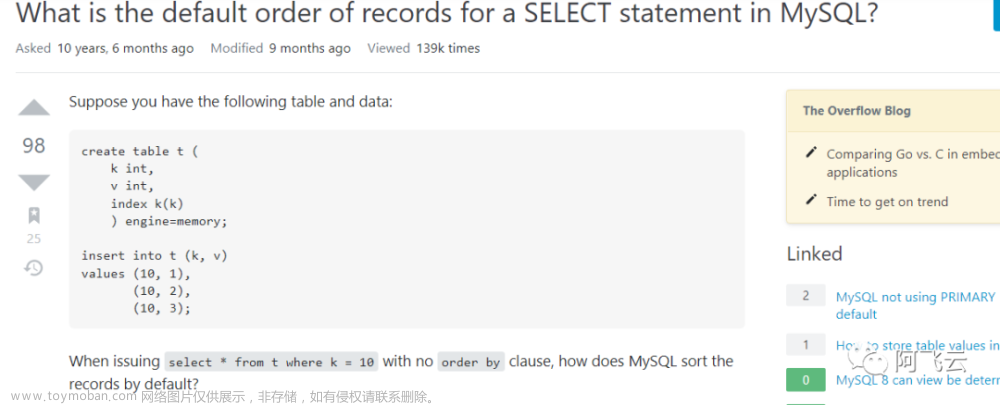一、简介
@Order:是 spring-core 包下的一个注解。@Order 作用是定义 Spring IOC 容器中 Bean 的执行顺序。
注意: Spring 的 @Order 注解或者 Ordered 接口,不决定 Bean 的加载顺序和实例化顺序,只决定 Bean 注入到 List 中的顺序。
@Order 注解接受一个整数值作为参数,数值越小表示优先级越高。当存在多个具有 @Order 注解的组件时,Spring Boot将按照数值从小到大的顺序加载它们。
需要注意的是:
- @Order 注解只能用于标记 Spring 容器中的组件,而不适用于标记普通的类。因此,在使用 @Order 注解时,确保你的组件被正确地注册到 Spring 容器中。
- @Order 注解只决定Bean的注入顺序,并不保证实际执行的顺序。例如:在 Web 应用中,Filter 的执行顺序并不受 @Order 注解影响。如果需要确保 Filter 按照顺序执行,可以使用 FilterRegistrationBean 来设置 Filter 的顺序。
二、List 注入使用示例
包结构如下:

2.1 测试接口类
IOrderTest 接口中定义了一个 handle() 方法用于测试。
IOrderTest.java
/**
* <p> @Title IOrderTest
* <p> @Description @Order注解测试接口
*
* @author ACGkaka
* @date 2023/10/17 11:20
*/
public interface IOrderTest {
/**
* 处理
*/
void handle();
}
2.2 测试接口实现类1
@Order注解测试实现类01 和 @Order注解测试实现类02 实现了 IOrderTest 接口,用于测试 @Order 的生效。
OrderTestImpl01.java
import com.demo.test.IOrderTest;
import org.springframework.core.annotation.Order;
import org.springframework.stereotype.Component;
/**
* <p> @Title OrderTestA
* <p> @Description @Order注解测试实现类01
*
* @author ACGkaka
* @date 2023/10/17 11:18
*/
@Order(1)
@Component
public class OrderTestImpl01 implements IOrderTest {
public OrderTestImpl01() {
System.out.println("=== OrderTestImpl01 constructor() ==");
}
@Override
public void handle() {
System.out.println("=== OrderTestImpl01 handle() ===");
}
}
2.3 测试接口实现类2
@Order注解测试实现类01 和 @Order注解测试实现类02 实现了 IOrderTest 接口,用于测试 @Order 的生效。
OrderTestImpl02.java
import com.demo.test.IOrderTest;
import org.springframework.core.annotation.Order;
import org.springframework.stereotype.Component;
/**
* <p> @Title OrderTestImpl02
* <p> @Description @Order注解测试实现类02
*
* @author ACGkaka
* @date 2023/10/17 11:18
*/
@Order(2)
@Component
public class OrderTestImpl02 implements IOrderTest {
public OrderTestImpl02() {
System.out.println("=== OrderTestImpl02 constructor() ===");
}
@Override
public void handle() {
System.out.println("=== OrderTestImpl02 handle() ===");
}
}
2.4 启动类(测试)
SpringbootDemoApplication.java
import com.demo.test.IOrderTest;
import org.springframework.boot.CommandLineRunner;
import org.springframework.boot.SpringApplication;
import org.springframework.boot.autoconfigure.SpringBootApplication;
import org.springframework.context.annotation.Bean;
import java.util.List;
@SpringBootApplication
public class SpringbootDemoApplication {
public static void main(String[] args) {
SpringApplication.run(SpringbootDemoApplication.class, args);
}
@Bean
public CommandLineRunner commandLineRunner(List<IOrderTest> list) {
return args -> {
System.out.println("=== CommandLineRunner ===");
list.forEach(IOrderTest::handle);
};
}
}
2.5 测试结果
场景一:
-
@Order(1)注解修饰 OrderTestImpl01.java -
@Order(2)注解修饰 OrderTestImpl02.java
执行结果如下:

场景二:
-
@Order(1)注解修饰 OrderTestImpl02.java -
@Order(2)注解修饰 OrderTestImpl01.java
执行结果如下:

三、CommandLineRunner 使用示例
3.1 接口实现类1
CommandLineRunner01.java
import org.springframework.boot.CommandLineRunner;
import org.springframework.core.annotation.Order;
import org.springframework.stereotype.Component;
/**
* <p> @Title CommandLineRunner01
* <p> @Description @Order注解测试01
*
* @author ACGkaka
* @date 2023/10/17 11:20
*/
@Component
@Order(1)
public class CommandLineRunner01 implements CommandLineRunner {
@Override
public void run(String... args) {
System.out.println("=== CommandLineRunner01 ===");
}
}
3.2 接口实现类2
CommandLineRunner02.java
import org.springframework.boot.CommandLineRunner;
import org.springframework.core.annotation.Order;
import org.springframework.stereotype.Component;
/**
* <p> @Title CommandLineRunner02
* <p> @Description @Order注解测试02
*
* @author ACGkaka
* @date 2023/10/17 11:20
*/
@Component
@Order(2)
public class CommandLineRunner02 implements CommandLineRunner {
@Override
public void run(String... args) {
System.out.println("=== CommandLineRunner02 ===");
}
}
3.3 测试结果
场景一:
-
@Order(1)注解修饰 CommandLineRunner01.java -
@Order(2)注解修饰 CommandLineRunner02.java
执行结果如下:

场景二:
-
@Order(1)注解修饰 CommandLineRunner02.java -
@Order(2)注解修饰 CommandLineRunner01.java
执行结果如下:

四、@Order失效场景
失效场景: 在
@Configuration里面通过@Bean方式创建 Bean,在上面加 @Order 控制顺序是没有效果的。
4.1 失效代码示例
SpringbootDemoApplication.java
import org.springframework.boot.CommandLineRunner;
import org.springframework.boot.SpringApplication;
import org.springframework.boot.autoconfigure.SpringBootApplication;
import org.springframework.context.annotation.Bean;
import org.springframework.core.annotation.Order;
@SpringBootApplication
public class SpringbootDemoApplication {
public static void main(String[] args) {
SpringApplication.run(SpringbootDemoApplication.class, args);
}
@Order(2)
@Bean
public CommandLineRunner commandLineRunner01() {
return args -> System.out.println("=== commandLineRunner01 ===");
}
@Order(1)
@Bean
public CommandLineRunner commandLineRunner02() {
return args -> System.out.println("=== commandLineRunner02 ===");
}
}
4.2 执行结果
由下图可知,虽然我们使用 @Order 注解明确声明要先执行 commandLineRunner02,但是并没有生效。

4.3 失效场景补救
在 @Order 注解失效的场景下,可以通过以下方式来控制顺序:
-
方式一: 可以通过具体实现类的方式创建 Bean,用
@Order+@Component注解修饰。 - 方式二: 可以通过 RegistrationBean 方式创建 Bean,用 setOrder 添加顺序。
- 方式三: filter 可以通过 FilterRegistrationBean 创建 filter 的 Bean,用 setOrder 添加顺序。
五、@Order、@Priority底层原理
看完 @Order 注解的时候,可能会疑惑 IOC 容器时如何通过 @Order 注解来控制程序的先后顺序的,接下来我们从源码层面看下,容器是如何加载的。
先说结论:
- @Order 底层是在 Bean 注入 IOC 容器之后执行的,所以无法控制 Bean 的加载顺序。
- @Order 底层是通过 List.sort(Comparator) 实现的,AnnotationAwareOrderComparator 类集成 OrderComparator 类,通过获取注解的 value 值实现了比对逻辑。
5.1 平平无奇的启动类
SpringbootDemoApplication.java
@SpringBootApplication
public class SpringbootDemoApplication {
public static void main(String[] args) {
SpringApplication.run(SpringbootDemoApplication.class, args);
}
}
5.2 神奇的 run() 方法
SpringApplication.run()
public ConfigurableApplicationContext run(String... args) {
StopWatch stopWatch = new StopWatch();
stopWatch.start();
ConfigurableApplicationContext context = null;
Collection<SpringBootExceptionReporter> exceptionReporters = new ArrayList<>();
configureHeadlessProperty();
SpringApplicationRunListeners listeners = getRunListeners(args);
listeners.starting();
try {
ApplicationArguments applicationArguments = new DefaultApplicationArguments(args);
ConfigurableEnvironment environment = prepareEnvironment(listeners, applicationArguments);
configureIgnoreBeanInfo(environment);
Banner printedBanner = printBanner(environment);
context = createApplicationContext();
exceptionReporters = getSpringFactoriesInstances(SpringBootExceptionReporter.class,
new Class[] { ConfigurableApplicationContext.class }, context);
prepareContext(context, environment, listeners, applicationArguments, printedBanner);
refreshContext(context);
afterRefresh(context, applicationArguments);
stopWatch.stop();
if (this.logStartupInfo) {
new StartupInfoLogger(this.mainApplicationClass).logStarted(getApplicationLog(), stopWatch);
}
listeners.started(context);
// #### 重点!!!调用具体的执行方法 ###
callRunners(context, applicationArguments);
}
catch (Throwable ex) {
handleRunFailure(context, ex, exceptionReporters, listeners);
throw new IllegalStateException(ex);
}
try {
listeners.running(context);
}
catch (Throwable ex) {
handleRunFailure(context, ex, exceptionReporters, null);
throw new IllegalStateException(ex);
}
return context;
}
5.3 开始排序的 callRunners() 方法
SpringApplication.callRunners()
private void callRunners(ApplicationContext context, ApplicationArguments args) {
List<Object> runners = new ArrayList<>();
runners.addAll(context.getBeansOfType(ApplicationRunner.class).values());
runners.addAll(context.getBeansOfType(CommandLineRunner.class).values());
// ### 重点!!!按照定义的优先级顺序排序 ###
AnnotationAwareOrderComparator.sort(runners);
for (Object runner : new LinkedHashSet<>(runners)) {
if (runner instanceof ApplicationRunner) {
callRunner((ApplicationRunner) runner, args);
}
if (runner instanceof CommandLineRunner) {
callRunner((CommandLineRunner) runner, args);
}
}
}
5.4 排序调用图
由于剩下的实现内容调用链比较长,为了看起来更清晰直观,采用顺序图展现出来:
5.5 排序的根源 findOrder() 方法
获取 @Order 注解的 value 值,来进行排序。
OrderUtils.findOrder()
@Nullable
private static Integer findOrder(MergedAnnotations annotations) {
MergedAnnotation<Order> orderAnnotation = annotations.get(Order.class);
if (orderAnnotation.isPresent()) {
// ### 重点!!!获取@Order注解的value值
return orderAnnotation.getInt(MergedAnnotation.VALUE);
}
MergedAnnotation<?> priorityAnnotation = annotations.get(JAVAX_PRIORITY_ANNOTATION);
if (priorityAnnotation.isPresent()) {
// ### 重点!!!获取@Priority注解的value值
return priorityAnnotation.getInt(MergedAnnotation.VALUE);
}
return null;
}
整理完毕,完结撒花~ 🌻
参考地址:
1.浅谈Spring @Order注解的使用,https://blog.csdn.net/yaomingyang/article/details/86649072
2.深入理解Spring的@Order注解和Ordered接口,https://blog.csdn.net/zkc7441976/article/details/112548075文章来源:https://www.toymoban.com/news/detail-829379.html
3.踩坑!@Order失效。。。https://blog.csdn.net/qq_34142184/article/details/126951618文章来源地址https://www.toymoban.com/news/detail-829379.html
到了这里,关于Spring(18) @Order注解介绍、使用、底层原理的文章就介绍完了。如果您还想了解更多内容,请在右上角搜索TOY模板网以前的文章或继续浏览下面的相关文章,希望大家以后多多支持TOY模板网!







